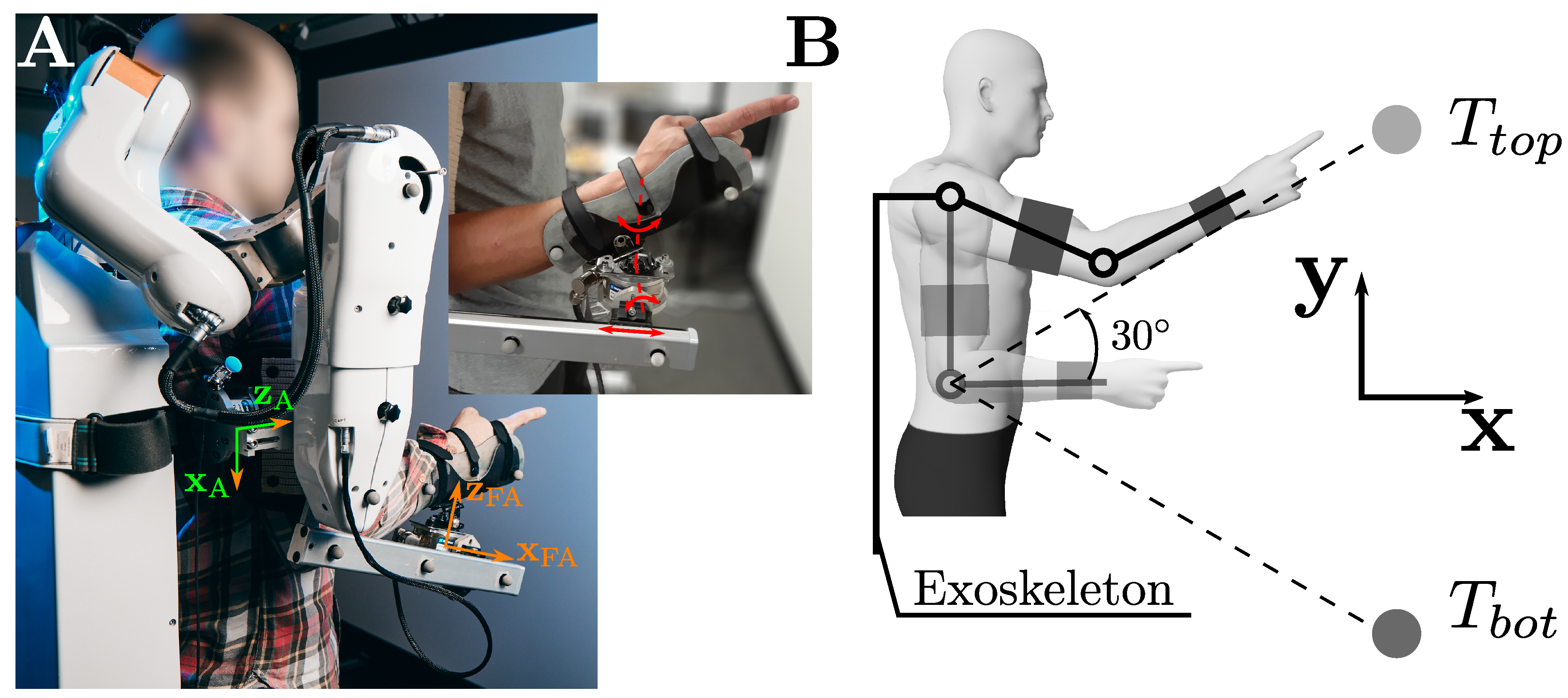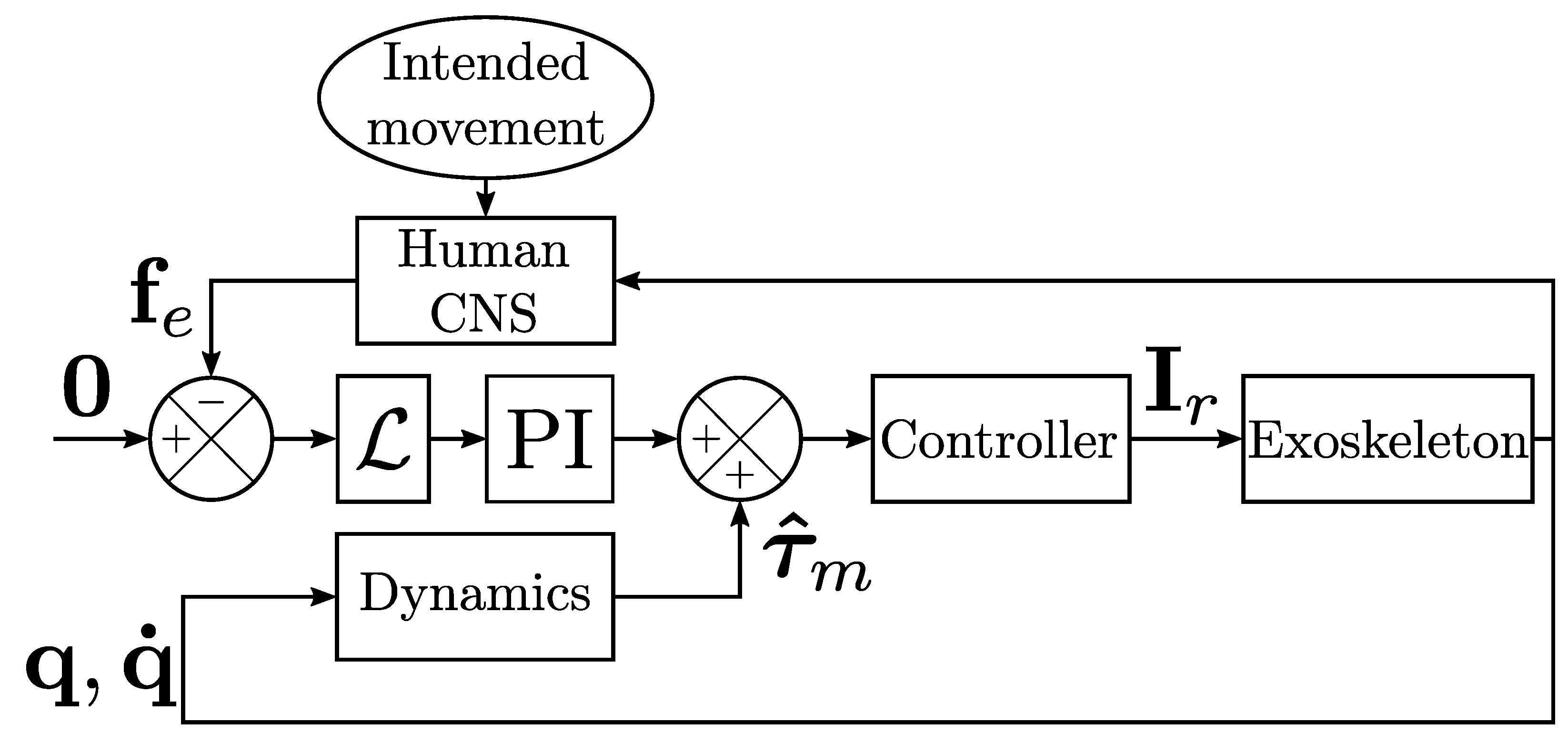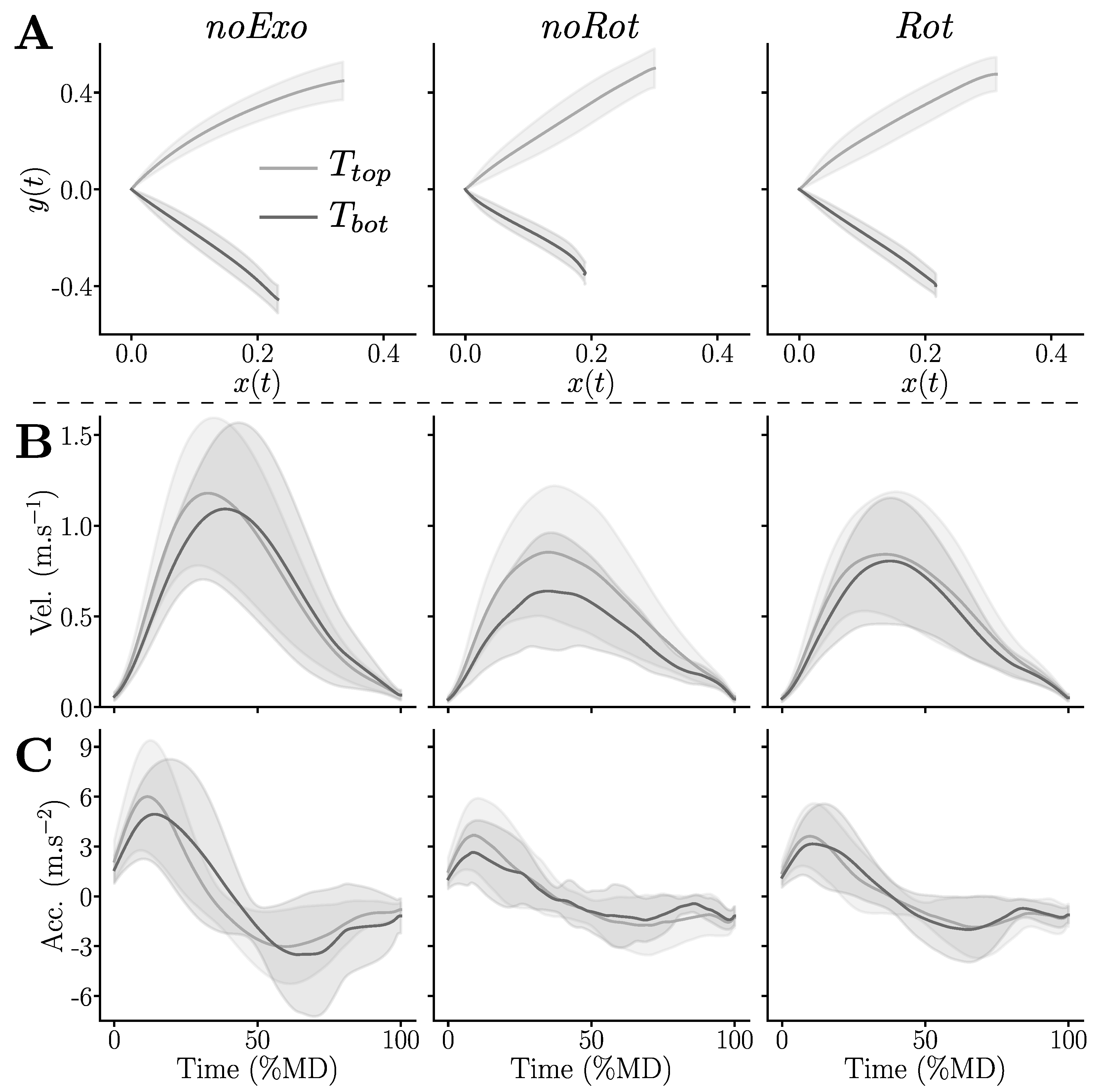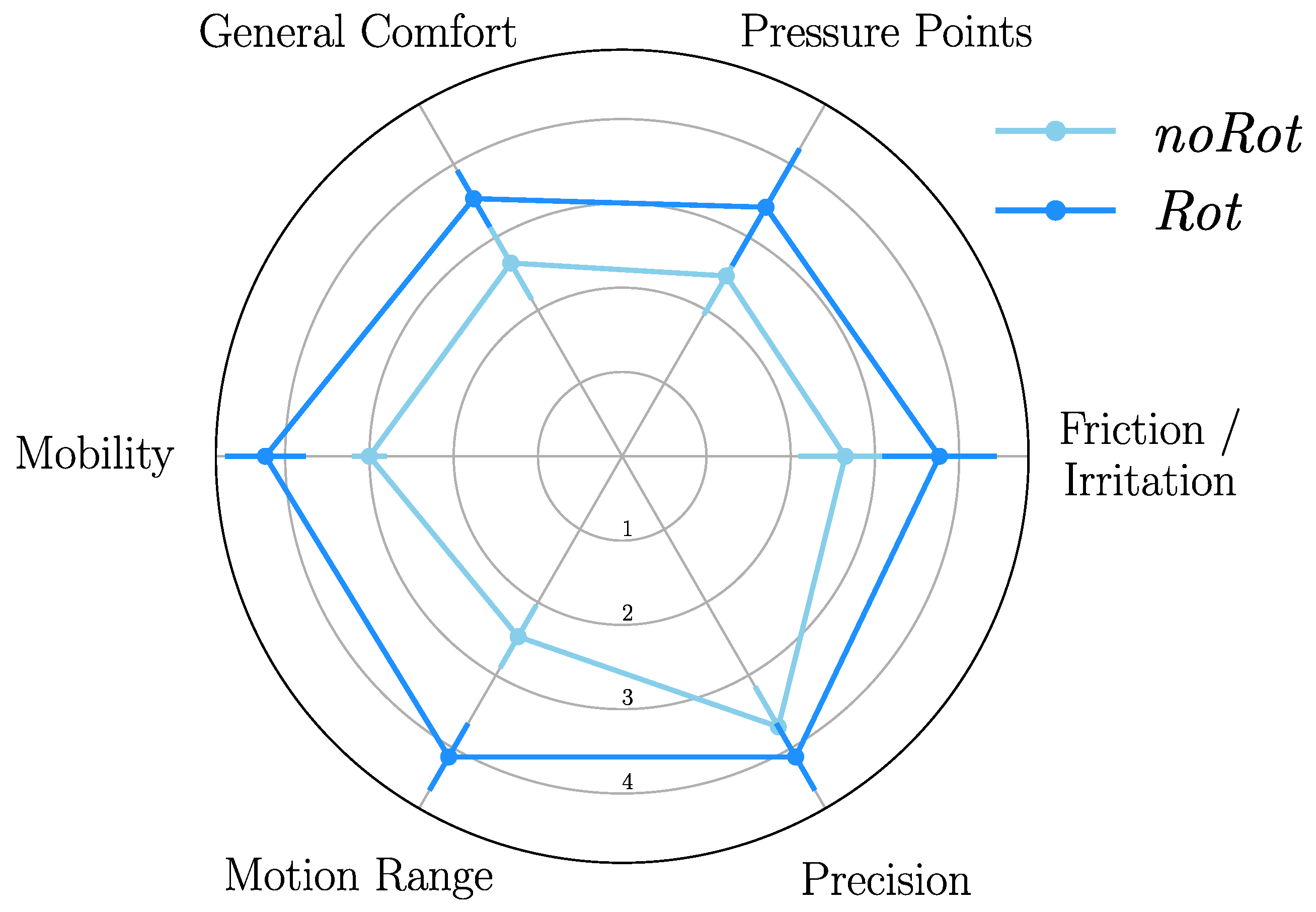A Trade-Off between Complexity and Interaction Quality for Upper Limb Exoskeleton Interfaces
Abstract
1. Introduction
2. Materials and Methods
2.1. Participants and Materials
2.1.1. Participants
2.1.2. Kinematic Recordings
2.1.3. EMG Recordings
2.1.4. Ergonomic Feedback Questionnaire
- Comfort:
- -
- Did you feel any friction or irritation during the movement? (negative)
- -
- Did you experience any pressure points at the level of the interfaces? (negative)
- -
- Rate the general comfort of movement with the current interfaces. (positive)
- Movement ability:
- -
- Rate the mobility with the current interfaces. (positive)
- -
- Did you feel any constraint on your motion range? (negative)
- Accuracy:
- -
- Was it easy to reach the targets? (positive)
2.1.5. ABLE Exoskeleton and Tested Interfaces
2.2. Evaluation Task
2.3. Data Processing
2.3.1. Kinematics
2.3.2. EMG
2.3.3. Interaction Efforts
2.4. Statistical Analysis
3. Results
3.1. Effects on Interaction Efforts
3.2. Effects on Human Movement Kinematics
3.3. Effects on Human Muscle Activities
3.4. Ergonomic Feedback
4. Discussion
5. Conclusions
Author Contributions
Funding
Institutional Review Board Statement
Informed Consent Statement
Data Availability Statement
Conflicts of Interest
References
- Pons, J.L. Rehabilitation exoskeletal robotics. IEEE Eng. Med. Biol. Mag. 2010, 29, 57–63. [Google Scholar] [CrossRef] [PubMed]
- Jarrassé, N.; Proietti, T.; Crocher, V.; Robertson, J.; Sahbani, A.; Morel, G.; Roby-Brami, A. Robotic exoskeletons: A perspective for the rehabilitation of arm coordination in stroke patients. Front. Hum. Neurosci. 2014, 8, 947. [Google Scholar] [CrossRef] [PubMed]
- Proietti, T.; Crocher, V.; Roby-Brami, A.; Jarrasse, N. Upper-Limb Robotic Exoskeletons for Neurorehabilitation: A Review on Control Strategies. IEEE Rev. Biomed. Eng. 2016, 9, 4–14. [Google Scholar] [CrossRef] [PubMed]
- Mehrholz, J.; Pollock, A.; Pohl, M.; Kugler, J.; Elsner, B. Systematic review with network meta-analysis of randomized controlled trials of robotic-assisted arm training for improving activities of daily living and upper limb function after stroke. J. Neuroeng. Rehabil. 2020, 17, 83. [Google Scholar] [CrossRef]
- Muramatsu, Y.; Kobayashi, H.; Sato, Y.; Jiaou, H.; Hashimoto, T.; Kobayashi, H. Quantitative performance analysis of exoskeleton augmenting devices—Muscle suit—For manual worker. Int. J. Autom. Technol. 2011, 5, 559–567. [Google Scholar] [CrossRef]
- Ajoudani, A.; Zanchettin, A.M.; Ivaldi, S.; Albu-Schäffer, A.; Kosuge, K.; Khatib, O. Progress and prospects of the human-robot collaboration. Auton. Robot. 2018, 42, 957–975. [Google Scholar] [CrossRef]
- de Looze, M.P.; Bosch, T.; Krause, F.; Stadler, K.S.; O’Sullivan, L.W. Exoskeletons for industrial application and their potential effects on physical work load. Ergonomics 2016, 59, 671–681. [Google Scholar] [CrossRef]
- Nussbaum, M.A.; Lowe, B.D.; de Looze, M.; Harris-Adamson, C.; Smets, M. An introduction to the special issue on occupational exoskeletons. IISE Trans. Occup. Ergon. Hum. Factors 2019, 7, 153–162. [Google Scholar] [CrossRef]
- Mallat, R.; Khalil, M.; Venture, G.; Bonnet, V.; Mohammed, S. Human-exoskeleton joint misalignment: A systematic review. In Proceedings of the IEEE 2019 Fifth International Conference on Advances in Biomedical Engineering (ICABME), Tripoli, Lebanon, 17–19 October 2019. [Google Scholar] [CrossRef]
- Schiele, A. An explicit model to predict and interpret constraint force creation in pHRI with exoskeletons. In Proceedings of the 2008 IEEE International Conference on Robotics and Automation, Pasadena, CA, USA, 19–23 May 2008. [Google Scholar] [CrossRef]
- Schiele, A.; van der Helm, F.C.T. Influence of attachment pressure and kinematic configuration on pHRI with wearable robots. Appl. Bionics Biomech. 2009, 6, 157–173. [Google Scholar] [CrossRef]
- Jarrasse, N.; Morel, G. Connecting a Human Limb to an Exoskeleton. IEEE Trans. Robot. 2012, 28, 697–709. [Google Scholar] [CrossRef]
- Galinski, D.; Sapin, J.; Dehez, B. Optimal design of an alignment-free two-DOF rehabilitation robot for the shoulder complex. In Proceedings of the 2013 IEEE 13th International Conference on Rehabilitation Robotics (ICORR), Seattle, WA, USA, 24–26 June 2013. [Google Scholar] [CrossRef]
- Zanotto, D.; Akiyama, Y.; Stegall, P.; Agrawal, S.K. Knee joint misalignment in exoskeletons for the lower extremities: Effects on user’s gait. IEEE Trans. Robot. 2015, 31, 978–987. [Google Scholar] [CrossRef]
- Verdel, D.; Sahm, G.; Bastide, S.; Bruneau, O.; Berret, B.; Vignais, N. Influence of the physical interface on the quality of human–exoskeleton interaction. IEEE Trans. Hum.-Mach. Syst. 2022, 53, 44–53. [Google Scholar] [CrossRef]
- Näf, M.B.; Junius, K.; Rossini, M.; Rodriguez-Guerrero, C.; Vanderborght, B.; Lefeber, D. Misalignment compensation for full human-exoskeleton kinematic compatibility: State of the art and evaluation. Appl. Mech. Rev. 2018, 70, 5. [Google Scholar] [CrossRef]
- Perry, J.C.; Rosen, J.; Burns, S. Upper-limb powered exoskeleton design. IEEE/ASME Trans. Mechatronics 2007, 12, 408–417. [Google Scholar] [CrossRef]
- Gupta, S.; Agrawal, A.; Singla, E. Architectural design and development of an upper-limb rehabilitation device: A modular synthesis approach. Disabil. Rehabil. Assist. Technol. 2022, 1–15. [Google Scholar] [CrossRef] [PubMed]
- Gupta, S.; Agrawal, A.; Singla, E. Toward avoiding misalignment: Dimensional synthesis of task-oriented upper-limb hybrid exoskeleton. Robotics 2022, 11, 74. [Google Scholar] [CrossRef]
- Nef, T.; Guidali, M.; Riener, R. ARMin III – arm therapy exoskeleton with an ergonomic shoulder actuation. Appl. Bionics Biomech. 2009, 6, 127–142. [Google Scholar] [CrossRef]
- Stienen, A.H.A.; Hekman, E.E.G.; Prange, G.B.; Jannink, M.J.A.; Aalsma, A.M.M.; van der Helm, F.C.T.; van der Kooij, H. Dampace: Design of an exoskeleton for force-coordination training in upper-extremity rehabilitation. J. Med. Devices 2009, 3, 031003. [Google Scholar] [CrossRef]
- Stienen, A.H.A.; Hekman, E.E.G.; van der Helm, F.C.T.; van der Kooij, H. Self-aligning exoskeleton axes through decoupling of joint rotations and translations. IEEE Trans. Robot. 2009, 25, 628–633. [Google Scholar] [CrossRef]
- Sergi, F.; Accoto, D.; Tagliamonte, N.L.; Carpino, G.; Galzerano, S.; Guglielmelli, E. Kinematic synthesis, optimization and analysis of a non-anthropomorphic 2-DOFs wearable orthosis for gait assistance. In Proceedings of the 2012 IEEE/RSJ International Conference on Intelligent Robots and Systems, Vilamoura-Algarve, Portugal, 7–12 October 2012. [Google Scholar] [CrossRef]
- Accoto, D.; Sergi, F.; Tagliamonte, N.L.; Carpino, G.; Sudano, A.; Guglielmelli, E. Robomorphism: A nonanthropomorphic wearable robot. IEEE Robot. Autom. Mag. 2014, 21, 45–55. [Google Scholar] [CrossRef]
- Beil, J.; Marquardt, C.; Asfour, T. Self-aligning exoskeleton hip joint: Kinematic design with five revolute, three prismatic and one ball joint. In Proceedings of the 2017 International Conference on Rehabilitation Robotics (ICORR), London, UK, 17–20 July 2017. [Google Scholar] [CrossRef]
- Junius, K.; Lefeber, N.; Swinnen, E.; Vanderborght, B.; Lefeber, D. Metabolic effects induced by a kinematically compatible hip exoskeleton during STS. IEEE Trans. Biomed. Eng. 2018, 65, 1399–1409. [Google Scholar] [CrossRef] [PubMed]
- Chen, C.F.; Du, Z.J.; He, L.; Shi, Y.J.; Wang, J.Q.; Xu, G.Q.; Zhang, Y.; Wu, D.M.; Dong, W. Development and hybrid control of an electrically actuated lower limb exoskeleton for motion assistance. IEEE Access 2019, 7, 169107–169122. [Google Scholar] [CrossRef]
- Housman, S.J.; Le, V.; Rahman, T.; Sanchez, R.J.; Reinkensmeyer, D.J. Arm-training with T-WREX after chronic stroke: Preliminary results of a randomized controlled trial. In Proceedings of the 2007 IEEE 10th International Conference on Rehabilitation Robotics, Noordwijk, The Netherlands, 13–15 June 2007. [Google Scholar] [CrossRef]
- Jarrasse, N.; Robertson, J.; Garrec, P.; Paik, J.; Pasqui, V.; Perrot, Y.; Roby-Brami, A.; Wang, D.; Morel, G. Design and acceptability assessment of a new reversible orthosis. In Proceedings of the 2008 IEEE/RSJ International Conference on Intelligent Robots and Systems, Nice, France, 22–26 September 2008. [Google Scholar] [CrossRef]
- Ergin, M.A.; Patoglu, V. ASSISTON-SE: A self-aligning shoulder-elbow exoskeleton. In Proceedings of the 2012 IEEE International Conference on Robotics and Automation, St Paul, MN, USA, 14–18 May 2012. [Google Scholar] [CrossRef]
- Li, J.; Cao, Q.; Dong, M.; Zhang, C. Compatibility evaluation of a 4-DOF ergonomic exoskeleton for upper limb rehabilitation. Mech. Mach. Theory 2021, 156, 104146. [Google Scholar] [CrossRef]
- Ning, Y.; Wang, H.; Tian, J.; Zhu, P.; Yang, C.; Niu, J. Design, optimization, and analysis of a human-machine compatibility upper extremity exoskeleton rehabilitation robot. Proc. Inst. Mech. Eng. Part J. Mech. Eng. Sci. 2022, 095440622211399. [Google Scholar] [CrossRef]
- Sarkisian, S.V.; Ishmael, M.K.; Lenzi, T. Self-aligning mechanism improves comfort and performance with a powered knee exoskeleton. IEEE Trans. Neural Syst. Rehabil. Eng. 2021, 29, 629–640. [Google Scholar] [CrossRef]
- Jarrassé, N.; Tagliabue, M.; Robertson, J.V.G.; Maiza, A.; Crocher, V.; Roby-Brami, A.; Morel, G. A Methodology to Quantify Alterations in Human Upper Limb Movement During Co-Manipulation With an Exoskeleton. IEEE Trans. Neural Syst. Rehabil. Eng. 2010, 18, 389–397. [Google Scholar] [CrossRef]
- Pirondini, E.; Coscia, M.; Marcheschi, S.; Roas, G.; Salsedo, F.; Frisoli, A.; Bergamasco, M.; Micera, S. Evaluation of the effects of the Arm Light Exoskeleton on movement execution and muscle activities: A pilot study on healthy subjects. J. Neuroeng. Rehabil. 2016, 13, 9. [Google Scholar] [CrossRef]
- Verdel, D.; Bastide, S.; Vignais, N.; Bruneau, O.; Berret, B. An identification-based method improving the transparency of a robotic upper-limb exoskeleton. Robotica 2021, 39, 1711–1728. [Google Scholar] [CrossRef]
- Voilque, A.; Masood, J.; Fauroux, J.C.; Sabourin, L.; Guezet, O. Industrial exoskeleton technology: Classification, structural analysis, and structural complexity indicator. In Proceedings of the IEEE 2019 Wearable Robotics Association Conference (WearRAcon), Scottsdale, AZ, USA, 25–27 March 2019. [Google Scholar] [CrossRef]
- Hermens, H.J.; Research, R.; Development, B.V. (Eds.) European Recommendations for Surface ElectroMyoGraphy: Results of the SENIAM Project; Number 8 in SENIAM; Roessingh Research and Development: Enschede, The Netherlands, 1999. [Google Scholar]
- Hart, S.G.; Staveland, L.E. Development of NASA-TLX (task load index): Results of empirical and theoretical research. In Advances in Psychology; Elsevier: Amsterdam, The Netherlands, 1988; pp. 139–183. [Google Scholar] [CrossRef]
- Maurice, P.; Camernik, J.; Gorjan, D.; Schirrmeister, B.; Bornmann, J.; Tagliapietra, L.; Latella, C.; Pucci, D.; Fritzsche, L.; Ivaldi, S.; et al. Objective and subjective effects of a passive exoskeleton on overhead work. IEEE Trans. Neural Syst. Rehabil. Eng. 2020, 28, 152–164. [Google Scholar] [CrossRef]
- Garrec, P.; Friconneau, J.P.; Méasson, Y.; Perrot, Y. ABLE, an Innovative Transparent Exoskeleton for the Upper-Limb. In Proceedings of the IEEE/RSJ International Conference on Intelligent Robots and Systems (IROS), Nice, France, 22–26 September 2008; pp. 1483–1488. [Google Scholar] [CrossRef]
- Garrec, P. Screw and Cable Acutators (SCS) and Their Applications to Force Feedback Teleoperation, Exoskeleton and Anthropomorphic Robotics. In Robotics 2010 Current and Future Challenges; IntechOpen: London, UK, 2010; pp. 167–191. [Google Scholar] [CrossRef]
- Rosen, J.; Brand, M.; Fuchs, M.B.; Arcan, M. A myosignal-based powered exoskeleton system. IEEE Trans. Syst. Man Cybern.—Part A Syst. Hum. 2001, 31, 210–222. [Google Scholar] [CrossRef]
- Rosen, J.; Perry, J.C. Upper limb powered exoskeleton. Int. J. Humanoid Robot. 2007, 4, 529–548. [Google Scholar] [CrossRef]
- Eiichi, Y.; Daisuke, H.; Masaaki, K. Development of an upper limb power assist system using pneumatic actuators for farming lift-up motion. J. Syst. Des. Dyn. 2009, 3, 781–791. [Google Scholar] [CrossRef]
- Ragonesi, D.; Agrawal, S.; Sample, W.; Rahman, T. Series elastic actuator control of a powered exoskeleton. In Proceedings of the 2011 Annual International Conference of the IEEE Engineering in Medicine and Biology Society, Boston, MA, USA, 30 August–3 September 2011. [Google Scholar] [CrossRef]
- Verdel, D.; Bastide, S.; Bruneau, O.; Berret, B.; Vignais, N. Improving and quantifying the transparency of an upper-limb robotic exoskeleton with a force sensor and electromyographic measures. 46ème Congrès Société Biomécanique, Computer Methods in Biomechanics and Biomedical Engineering Comput. Methods Biomech. Biomed. Eng. 2021, 24 (Suppl. 1), S261–S263. [Google Scholar] [CrossRef]
- Gentili, R.; Cahouet, V.; Papaxanthis, C. Motor planning of arm movements is direction-dependent in the gravity field. Neuroscience 2007, 1, 20–32. [Google Scholar] [CrossRef] [PubMed]
- Papaxanthis, C.; Pozzo, T.; Schieppati, M. Trajectories of arm pointing movements on the sagittal plane vary with both direction and speed. Exp. Brain Res. 2003, 148, 498–503. [Google Scholar] [CrossRef]
- Verdel, D.; Bastide, S.; Vignais, N.; Bruneau, O.; Berret, B. Human weight compensation with a backdrivable upper-limb exoskeleton: Identification and control. Front. Bioeng. Biotechnol. 2022, 9, 796864. [Google Scholar] [CrossRef]
- Bastide, S.; Vignais, N.; Geffard, F.; Berret, B. Interacting with a “transparent” upper-limb exoskeleton: A human motor control approach. In Proceedings of the IEEE/RSJ International Conference on Intelligent Robots and Systems (IROS), Madrid, Spain, 1–5 October 2018; pp. 4661–4666. [Google Scholar] [CrossRef]
- Potvin, J.R.; Brown, S.H.M. Less is more: High pass filtering, to remove up to 99% of the surface EMG signal power, improves EMG-based biceps brachii muscle force estimates. J. Electromyogr. Kinesiol. 2004, 14, 389–399. [Google Scholar] [CrossRef]
- Just, F.; Özhan, Ö.; Bösch, P.; Bobrovsky, H.; Klamroth-Marganska, V.; Riener, R.; Rauter, G. Exoskeleton transparency: Feed-forward compensation vs. disturbance observer. at-Automatisierungstechnik 2018, 66, 1014–1026. [Google Scholar] [CrossRef]
- Kermavnar, T.; Power, V.; de Eyto, A.; O’Sullivan, L.W. Computerized cuff pressure algometry as guidance for circumferential tissue compression for wearable soft robotic applications: A systematic review. Soft Robot. 2018, 5, 1–16. [Google Scholar] [CrossRef]
- Bessler, J.; Prange-Lasonder, G.B.; Schaake, L.; Saenz, J.F.; Bidard, C.; Fassi, I.; Valori, M.; Lassen, A.B.; Buurke, J.H. Safety assessment of rehabilitation robots: A review identifying safety skills and current knowledge gaps. Front. Robot. AI 2021, 8, 602878. [Google Scholar] [CrossRef]
- Vallat, R. Pingouin: Statistics in Python. J. Open Source Softw. 2018, 3, 1026. [Google Scholar] [CrossRef]
- Berret, B.; Baud-Bovy, G. Evidence for a cost of time in the invigoration of isometric reaching movements. J. Neurophysiol. 2022, 127, 689–701. [Google Scholar] [CrossRef] [PubMed]
- Verdel, D.; Bruneau, O.; Sahm, G.; Vignais, N.; Berret, B. The value of time in the invigoration of human movements when interacting with a robotic exoskeleton. bioRxiv 2023. [Google Scholar] [CrossRef]
- Berret, B.; Jean, F. Why Don’t We Move Slower? The Value of Time in the Neural Control of Action. J. Neurosci. 2016, 36, 1056–1070. [Google Scholar] [CrossRef] [PubMed]
- Berret, B.; Castanier, C.; Bastide, S.; Deroche, T. Vigour of self-paced reaching movement: Cost of time and individual traits. Sci. Rep. 2018, 8, 10655. [Google Scholar] [CrossRef] [PubMed]
- Shadmehr, R.; de Xivry, J.J.O.; Xu-Wilson, M.; Shih, T.Y. Temporal discounting of reward and the cost of time in motor control. J. Neurosci. 2010, 30, 10507–10516. [Google Scholar] [CrossRef]
- Shadmehr, R. Control of movements and temporal discounting of reward. Curr. Opin. Neurobiol. 2010, 20, 726–730. [Google Scholar] [CrossRef]
- Yandell, M.B.; Zelik, K.E. Preferred barefoot step frequency is influenced by factors beyond minimizing metabolic rate. Sci. Rep. 2016, 6, 23243. [Google Scholar] [CrossRef]
- Labaune, O.; Deroche, T.; Teulier, C.; Berret, B. Vigor of reaching, walking, and gazing movements: On the consistency of interindividual differences. J. Neurophysiol. 2020, 123, 234–242. [Google Scholar] [CrossRef]
- Fitts, R.H.; Riley, D.R.; Widrick, J.J. Functional and structural adaptations of skeletal muscle to microgravity. J. Exp. Biol. 2001, 204, 3201–3208. [Google Scholar] [CrossRef]
- Tanaka, H.; Krakauer, J.W.; Qian, N. An optimization principle for determining movement duration. J. Neurophysiol. 2006, 95, 3875–3886. [Google Scholar] [CrossRef] [PubMed]
- Berret, B.; Conessa, A.; Schweighofer, N.; Burdet, E. Stochastic optimal feedforward-feedback control determines timing and variability of arm movements with or without vision. PLoS Comput. Biol. 2021, 17, e1009047. [Google Scholar] [CrossRef] [PubMed]
- Verdel, D.; Bastide, S.; Geffard, F.; Bruneau, O.; Vignais, N.; Berret, B. Fast reoptimization of human motor patterns in non-Earth gravity fields locally induced by a robotic exoskeleton. bioRxiv 2022. [Google Scholar] [CrossRef]
- Li, Y.; Sena, A.; Wang, Z.; Xing, X.; Babič, J.; van Asseldonk, E.; Burdet, E. A review on interaction control for contact robots through intent detection. Prog. Biomed. Eng. 2022, 4, 032004. [Google Scholar] [CrossRef]






| Parameter | Condition | ANOVA | ||
|---|---|---|---|---|
| noExo | ||||
| () | noRot | |||
| Rot | ||||
| noExo | ||||
| Amp. () | noRot | |||
| Rot | ||||
| noExo | ||||
| () | noRot | |||
| Rot | ||||
| noExo | ||||
| () | noRot | |||
| Rot |
Disclaimer/Publisher’s Note: The statements, opinions and data contained in all publications are solely those of the individual author(s) and contributor(s) and not of MDPI and/or the editor(s). MDPI and/or the editor(s) disclaim responsibility for any injury to people or property resulting from any ideas, methods, instructions or products referred to in the content. |
© 2023 by the authors. Licensee MDPI, Basel, Switzerland. This article is an open access article distributed under the terms and conditions of the Creative Commons Attribution (CC BY) license (https://creativecommons.org/licenses/by/4.0/).
Share and Cite
Verdel, D.; Sahm, G.; Bruneau, O.; Berret, B.; Vignais, N. A Trade-Off between Complexity and Interaction Quality for Upper Limb Exoskeleton Interfaces. Sensors 2023, 23, 4122. https://doi.org/10.3390/s23084122
Verdel D, Sahm G, Bruneau O, Berret B, Vignais N. A Trade-Off between Complexity and Interaction Quality for Upper Limb Exoskeleton Interfaces. Sensors. 2023; 23(8):4122. https://doi.org/10.3390/s23084122
Chicago/Turabian StyleVerdel, Dorian, Guillaume Sahm, Olivier Bruneau, Bastien Berret, and Nicolas Vignais. 2023. "A Trade-Off between Complexity and Interaction Quality for Upper Limb Exoskeleton Interfaces" Sensors 23, no. 8: 4122. https://doi.org/10.3390/s23084122
APA StyleVerdel, D., Sahm, G., Bruneau, O., Berret, B., & Vignais, N. (2023). A Trade-Off between Complexity and Interaction Quality for Upper Limb Exoskeleton Interfaces. Sensors, 23(8), 4122. https://doi.org/10.3390/s23084122








